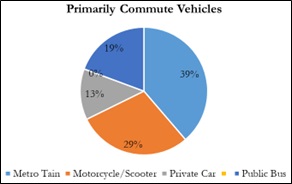Analyzing the Contribution of Transportation in Formation of Smog in District Lahore, Pakistan
Keywords:
Smog, Transportation Emissions, Lahore, Air Pollution, Vehicular Emissions.Abstract
Introduction: Globally, smog has become a growing environmental issue, largely due to rising pollution from both anthropogenic and natural sources. In Lahore, a densely populated city in Pakistan, this problem is intensified by rapid urbanization, transportation emissions, and activities related to industry and agriculture.
Novelty: This research highlights these factors as primary contributors to smog and utilizes a quantitative approach to evaluate their impacts, particularly focusing on the role of transportation in smog formation.
Methodology: The study examines data on vehicular emissions, traffic patterns, and meteorological conditions to explore the relationship between transportation activities and smog. Data collection was performed via an online questionnaire survey. This data was then mapped onto traffic congestion areas and major industrial pollution sources, with charts created to depict public perceptions of the issue.
Results and Discussion: The results show that vehicles are a significant source of smog, emitting NOx, VOCs, and particulate matter (PM). Older vehicles, especially those lacking modern pollution control technologies, emit far more pollutants per kilometer than newer models that adhere to stringent emission standards. Traffic congestion during peak hours leads to extended vehicle idling, which increases fuel consumption and emissions. Additionally, stop-and-go traffic conditions further heighten fuel use and pollutant release.
Concluding Remarks: Tackling transportation-related smog is essential and necessitates effective management and policies at the local, regional, and national levels. Public-private partnerships can be instrumental in advancing cleaner technologies and practices within the transportation sector to mitigate smog.
References
M. Ali and M. Athar, “Impact of transport and industrial emissions on the ambient air quality of Lahore City, Pakistan,” Environ. Monit. Assess., vol. 171, no. 1–4, pp. 353–363, Dec. 2010, doi: 10.1007/S10661-009-1283-0/METRICS.
M. Nadeem, A. Aziz, M. A. Al-Rashid, G. Tesoriere, M. Asim, and T. Campisi, “Scaling the Potential of Compact City Development: The Case of Lahore, Pakistan,” Sustain. 2021, Vol. 13, Page 5257, vol. 13, no. 9, p. 5257, May 2021, doi: 10.3390/SU13095257.
Z. Naveed and U. Khayyam, “Smog and cognitive issues in the school going children of Lahore and Islamabad, Pakistan,” Int. J. Environ. Sci. Technol., vol. 20, no. 4, pp. 4151–4166, Apr. 2023, doi: 10.1007/S13762-022-04264-Y/METRICS.
W. Raza et al., “A review on the deteriorating situation of smog and its preventive measures in Pakistan,” J. Clean. Prod., vol. 279, p. 123676, Jan. 2021, doi: 10.1016/J.JCLEPRO.2020.123676.
M. Garelnabi, K. Lor, J. Jin, F. Chai, and N. Santanam, “The paradox of ApoA5 modulation of triglycerides: Evidence from clinical and basic research,” Clin. Biochem., vol. 46, no. 1–2, pp. 12–19, Jan. 2013, doi: 10.1016/J.CLINBIOCHEM.2012.09.007.
A. Abbas, S., Khattak, Z. A., Ur Rehman, I., Mahmood, “Vehicular emissions scenario and associated human health impacts in Lahore, Pakistan,” Environ. Pollut., vol. 267, pp. 115–454, 2020.
B. Butt, A. R., Sarfraz, M., Ali, M. S., Shahzad, “Air Quality Assessment of Lahore Division, Pakistan: Spatial and Seasonal Variations.,” Environ. Model. Assess., vol. 26, no. 1, pp. 15–31, 2021.
M. Farooqi, S. I., Ahmad, S., Ali, M., Danish, “A review on the traffic congestion, air quality and fuel quality in Pakistan.,” Transp. Res. Part D Transp. Environ., vol. 84, 2020.
M. A. Khwaja and T. Shams, “Pakistan National Ambient Air Quality Standards: A comparative Assessment with Selected Asian Countries and World Health Organization (WHO),” 2020, Accessed: Jul. 28, 2024. [Online]. Available: www.sdpi.org
F. Khanum, M. N. Chaudhry, and P. Kumar, “Characterization of five-year observation data of fine particulate matter in the metropolitan area of Lahore,” Air Qual. Atmos. Heal., vol. 10, no. 6, pp. 725–736, 2017, doi: 10.1007/s11869-017-0464-1.
W. Huang, J., Zhao, H., Wu, H., Lv, “Modeling vehicular emissions and their contribution to urban air pollution in Lahore,” Atmos. Pollut. Res., vol. 11, no. 8, pp. 1314–1325, 2020.
L. Zhang, Y., Xie, S., Wei, W., Hu, “A Review of Urban Air Pollution Monitoring and Prediction in Lahore,” Curr. Popul. Reports, vol. 5, no. 4, pp. 377–386, 2019.
H. Liu, Q. Li, D. Yu, and Y. Gu, “Air Quality Index and Air Pollutant Concentration Prediction Based on Machine Learning Algorithms,” Appl. Sci. 2019, Vol. 9, Page 4069, vol. 9, no. 19, p. 4069, Sep. 2019, doi: 10.3390/APP9194069.
A. R. Naseem, S., Irfan, M., Waheed, A., Butt, “Air pollution and its impacts on human health in Lahore, Pakistan.,” Int. J. Environ. Sustain. Dev., vol. 18, no. 2, pp. 183–197, 2019.
L. Wang, Y., Wang, J., Zhang, C., Wang, Y., Li, H., Wang, “Quantitative analysis of the influence of traffic congestion on vehicular emissions in Lahore, Pakistan.,” Int. J. Environ. Res. Public Health, vol. 18, no. 7, 2021.
N. Rasheed, A., Rehman, S., Ahmad, “Assessment of traffic congestion and air quality in Lahore, Pakistan,” Environ. Sci. Pollut. Res., vol. 26, no. 8, pp. 8091–8103, 2019.
M. Ahmad, M. S., Farooq, M., Khadim, H., Zia-ur-Rehman, “Association of shortterm exposure to air pollution with cardiovascular emergency department visits: A time series study in Lahore, Pakistan,” Environ. Res., vol. 195, 2021.
R. A. Shah, M. T., Shamshad, S., Khattak, “Air quality of the urban area of Lahore, Pakistan in relation to metallic pollution.,” Environ. Earth Sci., vol. 77, no. 24, pp. 1–9, 2018.
A. Shaheen, N., Ahmad, S., Ali, M., Fida, “Assessment of heavy metals in atmospheric particulate matter of Lahore, Pakistan.,” Environ. Sci. Pollut. Res., vol. 25, no. 17, pp. 17004–17014, 2018.
“Sectoral Emission Inventory of Lahore”, [Online]. Available: https://urbanunit.gov.pk/Download/publications/Files/8/2023/Emission Inventory of Lahore 2023.pdf
A. U. Bajwa and H. A. Sheikh, “Contribution of Road Transport to Pakistan’s Air Pollution in the Urban Environment,” Air 2023, Vol. 1, Pages 237-257, vol. 1, no. 4, pp. 237–257, Nov. 2023, doi: 10.3390/AIR1040018.
J. Slater et al., “Modeling Air Pollutant Emission Reductions from Implementation of Pakistan’s 2023 Clean Air Policy,” ACS ES&T Air, Jun. 2024, doi: 10.1021/ACSESTAIR.4C00003.

Downloads
Published
How to Cite
Issue
Section
License
Copyright (c) 2024 50sea

This work is licensed under a Creative Commons Attribution 4.0 International License.




















